Boletus L.
Recent molecular studies have shown that Boletus in its current circumscription is likely an artificial grouping and it is possible that it will be split at some point into smaller genera. Note that Boletus impolitus and Boletus depilatus for practical reasons are retained here, although there is strong evidence that they are closely related to Xerocomus subtomentosus and its allies.
Fruitbody large to medium sized, boletoid, without veil and ring. Stipe solid, with surface usually covered with granules or network. Flesh variously coloured, changing or not when exposed to air. Tubes easily separable from each other, not tearing apart. Pores usually small and rounded.
Boletus poikilochromus Pöder, Cetto & Zuccherelli
Description
Cap up to 15 cm, at first hemispherical, later convex to flat-convex, smooth or slightly viscid in wet weather, yellowish ochraceous, yellowish brown, orange brown, pale brown, brown or dark brown, often irregularly spotted. Stipe club-shaped, swollen or cylindrical, often rooting, in the upper part most often cream or pale to bright yellow, downwards reddish brown to rusty, sometimes entirely yellow or brownish, with more or less developed yellow to reddish brown, brown or rusty network, stipe surface blueing after handling. Flesh initially lemon yellow, later whitish in the cap and pale lemon yellow in the stipe, blueing when exposed to air. Tubes initially lemon yellow, then yellow with olivaceous tint, blueing when injured. Pores yellow, often developing somewhat rusty tint with age, blueing when bruised. Smell strong and persistent, somewhat of fermenting fruits. Taste not distinctive. Spores 11–13.5 × 4.5–5.5 μm, ratio 2.2–2.7. Pileipellis (the cap cuticle) trichodermium of interwoven septate hyphae of cylindrical, finely incrusted cells.
Habitat. Broadleaf and coniferous forests in the Mediterranean, mycorrhizal with oaks (Quercus) or pines (Pinus).
Distribution. In Europe known only in the Mediterranean area – France, Greece, Italy, Portugal, Spain (incl. Balearic Islands). In east reaches as far as Israel.
Similarity. Compare with Boletus luridus which has differently coloured cap, red pores and orange, red to vinaceous (not yellow) flesh under the tubes. See also Boletus torosus.
Photographs
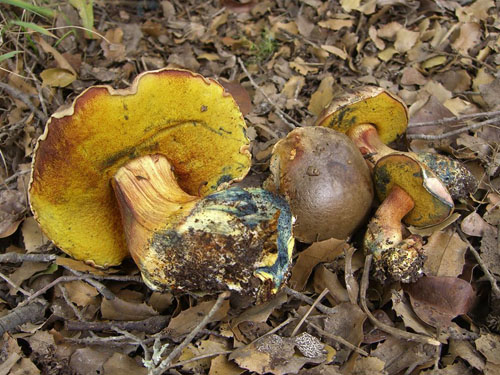
Typical fruitbodies of Boletus poikilochromus. Note the colour of the pores and the blueing. (photo R. Kuznetsov)

Fruitbodies of Boletus poikilochromus. (photo R. Kuznetsov)
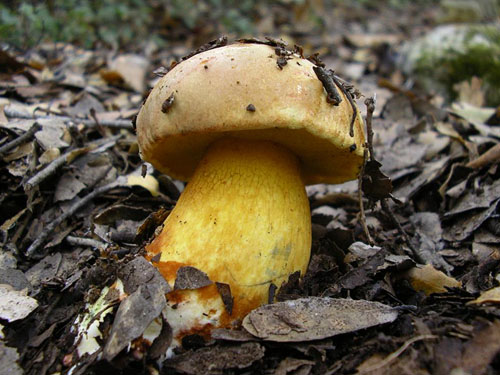
Fruitbody of Boletus poikilochromus. Note the network on the stipe. (photo Z. Shafranov)
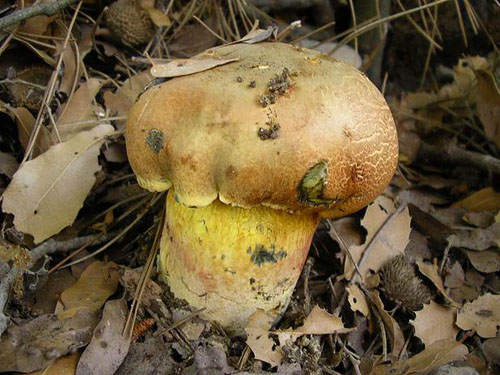
Fruitbody of Boletus poikilochromus. (photo Z. Shafranov)

Fruitbody of Boletus poikilochromus. Note the network and the blueing flesh. (photo Z. Shafranov)
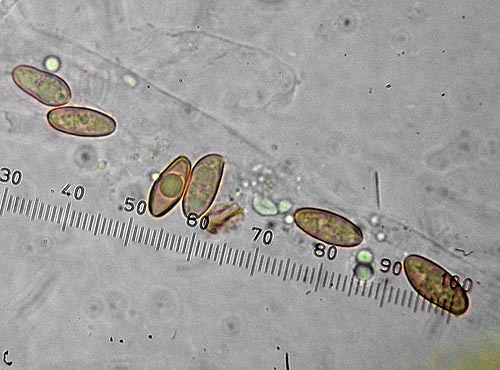
Basidiospores of Boletus poikilochromus. (photo G. Konstantinidis)

Boletus poikilochromus - pileipelis hyphae (photo G. Konstantinidis)
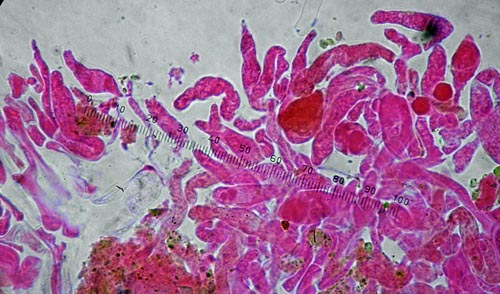
Boletus poikilochromus - caulocystidia (photo G. Konstantinidis)
Important literature
Biketova, A. Yu., Kosakyan, A., Wasser, S.P. & Nevo, E. New, noteworthy, and rare species of the genus Boletus in Israel. – Plant Biosystems [in press]
Boix, S., Moisés, J., Llistosella, J. & Llorens van Waveren, L. 2011. Boletus poikilochromus Pöder, Cetto & Zuccher., una rara espècie mediterrània trobada a Catalunya. – Revista Catalana de Micologia 33: 95–99.
Calonge, F.D. & Redeuilh, G. 2000. Boletus poikilochromus Pöder, Cetto & Zuccherelli, una especie mediterranea hallada por primera vez en España. – Boletín de la Sociedad Micológica de Madrid 25: 277–280.
Cetto, B. 1983. I Funghi dal Vero. Arti Grafiche Saturnia, Trento.
Estadès, A. & Lannoy, G. 2004. Les bolets européens. – Bulletin Mycologique et Botanique Dauphiné-Savoie 44(3): 3–79.
Galli, R. 1998. I Boleti. Atlante pratico-monographico per la determinazione dei boleti. Edinatura, Milano.
Lannoy, G. & Estadès, A. 2001. Les Bolets. Flore mycologique d’Europe. Documents Mycologiques Mémoire Hors série no. 6. Pp. 1–163. Association d’Écologie et de Mycologie, Lille.
Muñoz, J.A. 2005. Boletus s. l. – In: Fungi Europaei. Vol. 1. Pp. 1–951. Edizioni Candusso, Alassio.
Pöder, R. 1987. Eine neue Boletus-art aus der Sektion Luridi: Boletus poikilochromus sp. n. – Mycologia Helvetica 2: 155–163.
Simonini, G. 1995. I Boleti della sezione Luridi a viraggio violento: problemi tassonomici. – Mycologia e Vegetazione Mediterranea 10: 88–112.
Šutara, J., Mikšík, M. & Janda, V. 2009. Hřibovité houby. Čeled’ Boletaceae a rody Gyrodon, Gyroporus, Boletinus a Suillus. Academia, Praha.
Κωνσταντινίδης, Γ. 2009. Μανιτάρια, φωτογραφικός οδηγός μανιταροσυλλέκτη. Αυτοέκδοση, Αθήνα. [Konstantinidis, G. 2009. Mushrooms, a photographic guide for collectors. Published by the author, Athens.]